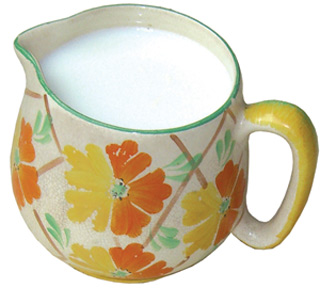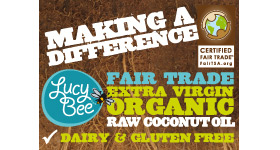|
|
|
Raw Milk Juliette Scarfe is a skincare expert and beauty therapist (and, as it happens, a solicitor) with her own range of beauty products, Bare Skin Beauty. She is also a very passionate raw milk enthusiast...
History of raw milk Pasteurisation Pasteurisation is a mechanical process used to kill harmful microorganisms, using intense heat for short periods of time – intended to make milk safer to consume. The heat destroys all the bacteria in the milk, including beneficial lactobacillus strains as well as pathogenic E Coli and others – much like antibiotics destroy all bacteria; both good and bad in our gut. Pasteurisation also destroys enzymes and denatures amino acids, making the milk devoid of "living nutrients." Homogenisation By contrast Homogenisation is a mechanical process used in the production of non-organic milk, where centrally collected milk from numerous different herds and dairies is passed through a valve under high pressure. This breaks apart fat molecules into much smaller droplets measuring between 0.2 to 2 microns in size. These high-pressure generated micro-droplets will stay dispersed, creating the "cohesive" texture we are used to in standard milk. As milk has a tendency to separate - homogenization was created in response to consumer demand for smooth milk that was even in fat levels throughout. This process is particularly harmful because it creates a noxious enzyme called Xanthine Oxidase (XO). XO passes through the walls of the digestive system and goes directly into the bloodstream. XO is known to be highly reactive and to damage and inflame the arterial tissue, producing arterial plaque. Nutritional benefits of raw milk Vitamins: Minerals:
However, those who are intolerant to milk and dairy often find, in my experience that they can tolerate raw milk beautifully. I believe that those who have been diagnosed as dairy intolerant are in fact, intolerant to the natural sugar, lactose found in milk. Nature is perfection and in raw milk you find lactose and the enzyme lactase, which breaks down and metabolises the sugar in perfect harmony. The high temperatures used in the pasteurisation process destroys lactase. Without this digestive enzyme, and help from the beneficial bacteria, the body is incapable of breaking down the lactase and therefore it leads to inflammation in the gut – which produces the symptoms of intolerance. Approximately 70% of the world population is lactose intolerant and would benefit from consuming raw milk.
Take your favourite mug and fill it ¾ with raw cream and then ¼ with ideally raw or wild crafted honey – mix well. Pour directly into the water flow, turn off your phone and relax for a minimum of 30 minutes. This bath is perfect for babies and infants and has a very calming effect – ideal as a bedtime bath. References: A European study (PARSIFAL), conducted in 2007 by a team from the Institute of Social and Preventive Medicine in Basel, looked at 14,893 children aged between 5 and 13 living in rural areas of Austria, Germany, the Netherlands, Sweden and Switzerland, comparing the consumption of farm milk (raw or boiled) versus pasteurized shop milk. It showed that farm milk consumption was associated with a reduction in asthma (-26%), hay fever (-33%) and food allergies (-58%). A more recent study published in 2011 (GABRIEL) investigated whether raw milk could make a difference versus boiled milk in the frequency of asthma and allergies. Selecting and analysing of 800 farm children the study shows that there is an additional protecting effect within the group of farm children who have been given raw milk. The strongest reduction was found in the risk of hay fever and asthma among the 'exclusive raw milk drinkers' (any unboiled milk). Just the boiling of the milk leads to a loss of theprotective effect found in the exclusive raw milk drinkers.
First published May 2013
Click here for more articles
|

 Why do I feel so passionate about raw milk? As a skincare expert I strive to solve and support even the most complex skin conditions, in both the young and the old. I have been using raw milk as part of my natural apothecary and nutrition practice for over a year and the results have been incredible.
Why do I feel so passionate about raw milk? As a skincare expert I strive to solve and support even the most complex skin conditions, in both the young and the old. I have been using raw milk as part of my natural apothecary and nutrition practice for over a year and the results have been incredible. We all need to take some time out to nourish and pamper our bodies and there is no better way than soaking in a decadent bath. If you suffer with eczema, psoriasis or dermatitis this bath will heal and regenerate your skin.
We all need to take some time out to nourish and pamper our bodies and there is no better way than soaking in a decadent bath. If you suffer with eczema, psoriasis or dermatitis this bath will heal and regenerate your skin. 






